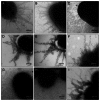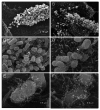Multi-functional analysis of Klebsiella pneumoniae fimbrial types in adherence and biofilm formation
- PMID: 23302788
- PMCID: PMC3654611
- DOI: 10.4161/viru.22974
Multi-functional analysis of Klebsiella pneumoniae fimbrial types in adherence and biofilm formation
Abstract
Klebsiella pneumoniae is an opportunistic pathogen frequently associated with nosocomially acquired infections. Host cell adherence and biofilm formation of K. pneumoniae isolates is mediated by type 1 (T1P) and type 3 (MR/K) pili whose major fimbrial subunits are encoded by the fimA and mrkA genes, respectively. The E. coli common pilus (ECP) is an adhesive structure produced by all E. coli pathogroups and a homolog of the ecpABCDE operon is present in the K. pneumoniae genome. In this study, we aimed to determine the prevalence of these three fimbrial genes among a collection of 69 clinical and environmental K. pneumoniae strains and to establish a correlation with fimbrial production during cell adherence and biofilm formation. The PCR-based survey demonstrated that 96% of the K. pneumoniae strains contained ecpA and 94% of these strains produced ECP during adhesion to cultured epithelial cells. Eighty percent of the strains forming biofilms on glass produced ECP, suggesting that ECP is required, at least in vitro, for expression of these phenotypes. The fim operon was found in 100% of the strains and T1P was detected in 96% of these strains. While all the strains examined contained mrkA, only 57% of them produced MR/K fimbriae, alone or together with ECP. In summary, this study highlights the ability of K. pneumoniae strains to produce ECP, which may represent a new important adhesive structure of this organism. Further, it defines the multi-fimbrial nature of the interaction of this nosocomial pathogen with host epithelial cells and inert surfaces.
Keywords: E. coli common pilus; K. oxytoca; Klebsiella pneumoniae; adherence; biofilms.
Figures







References
-
- Schwaber MJ, Lev B, Israeli A, Solter E, Smollan G, Rubinovitch B, et al. Israel Carbapenem-Resistant Enterobacteriaceae Working Group Containment of a country-wide outbreak of carbapenem-resistant Klebsiella pneumoniae in Israeli hospitals via a nationally implemented intervention. Clin Infect Dis. 2011;52:848–55. doi: 10.1093/cid/cir025. - DOI - PubMed
-
- Souli M, Galani I, Antoniadou A, Papadomichelakis E, Poulakou G, Panagea T, et al. An outbreak of infection due to beta-Lactamase Klebsiella pneumoniae Carbapenemase 2-producing K. pneumoniae in a Greek University Hospital: molecular characterization, epidemiology, and outcomes. Clin Infect Dis. 2010;50:364–73. doi: 10.1086/649865. - DOI - PubMed
Publication types
MeSH terms
Substances
Grants and funding
LinkOut - more resources
Full Text Sources
Other Literature Sources
